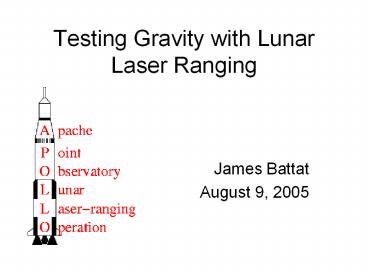Testing Gravity with Lunar Laser Ranging - PowerPoint PPT Presentation
1 / 21
Title:
Testing Gravity with Lunar Laser Ranging
Description:
Thank you Buzz Aldrin... 36 years and counting. Motivation for LLR ... Possibility that GR cannot explain data. Unification of gravity with other forces ... – PowerPoint PPT presentation
Number of Views:95
Avg rating:3.0/5.0
Title: Testing Gravity with Lunar Laser Ranging
1
Testing Gravity with Lunar Laser Ranging
- James Battat
- August 9, 2005
2
Point Strong Laser at Moon
20 Hz pulses 2.5 second round trip
travel time. 50 pulses in air simultaneously
3
Aim for Retroreflectors
Thank you Buzz Aldrin 36 years and counting.
4
Motivation for LLR
- Test fundamental physical phenomena.
- Push GR tests by 10x
- Possibility that GR cannot explain data.
- Unification of gravity with other forces
- New clues to explain existing paradigm.
5
LLR is the best test of
- Strong equivalence principle
- Gravitomagnetism
- dG/dt
- Geodetic precession (de Sitter)
- Long range forces
6
10x Better Range Accuracy
7
10x Better Range Accuracy
8
APOLLOs Capabilities
- Weak Equivalence Principle to ?a/a 10-14
- Strong Equivalence Principle to ? 310-5
- Gravitomagnetism (frame dragging) to 10-4
- dG/dt to 10-13G per year
- Geodetic precession to 310-4
- Long range forces to 10-11 the strength of
gravity
Timescales to achieve stated 1-s results vary
according to the nature of the signal.
9
Equivalence Principles
- Weak Equivalence Principle
- Objects follow the same trajectory in a
gravitational field irrespective of their
internal structure and composition. - Testable in the lab
- Strong Equivalence Principle
- WEP is valid for self-gravitating bodies
- Gravitational self-energy has mass
- Does this mass accelerate the same as other mass?
- Mg/Mi 1.00000 ?
10
Push the Equivalence Principle Test
- Thibault Damour
11
Gravitational Self-Energy
12
Nordtvedt Effect Visualized
Nordtvedt, Phys Rev, 169, 1014,
1968 Nordtvedt, Phys Rev, 169, 1017,
1968 Nordtvedt, Phys Rev, 170, 1186, 1968
13
APOLLO is at APO In New Mexico
- Elevation 2,788 m
- 32 46 49 N105 49 13 W
- 3.5 m diameter dish
- Median Seeing lt1
14
The APO 3.5 meter
15
The Action is at the Back
Telescope boresite
16
The Action is at the Back
Telescope boresite
- Timing Electronics
- Laser
- APD Detectors
- Control Computer
- Thermal Control
17
The Laser Firing
18
APD Detectors
- MIT Lincoln Labs
- Single ? detectors
- 50 efficiency
- 50 ps timing jitter(7 mm one-way)
19
Some Challenges
- Lunar crustal tides (4 m)
- Earth crustal tides (20 cm)
- Solar radiation pressure (4 mm)
20
Some Solutions
- Geophysical metrology
- High precision GPS
- Gravimetry
- Detailed ephemeris modeling
- Harvard, JPL
- Included manifold geophysical effects
- Signal at known frequency
21
F I R S T L I G H T
22
F I R S T L I G H T
23
APOLLO Summary
- LLR is an incisive probe of gravity.
- Any known GR alternative violates SEP .
- 1mm ranging improves constraints by 10x.
- Geo-metrology and models account for
contaminating effects. - APOLLO data is imminent.
24
APOLLO Collaboration
Harvard Christopher Stubbs James
Battat UCSD Tom Murphy Eric Michelsen Adam
Orin U. Washington Eric Adelberger Erik
Swanson C. D. Hoyle
JPL Jim Williams Jean Dickey Slava
Turyshev Lincoln Labs Brian Aull Bernie
Kosicki Bob Reich Northwest Analysis Ken
Nordtvedt































